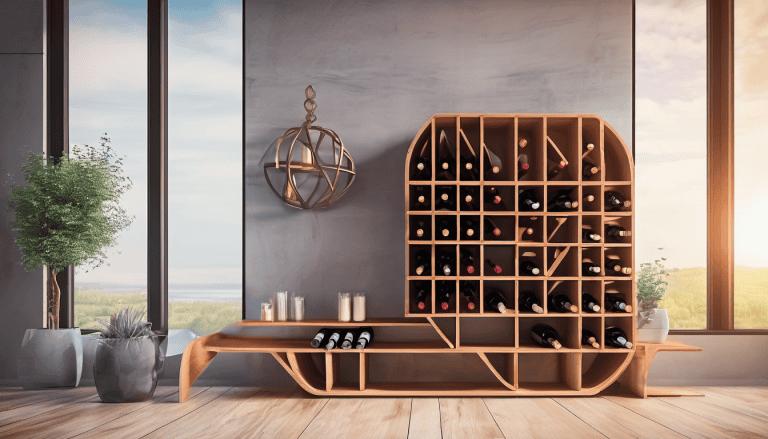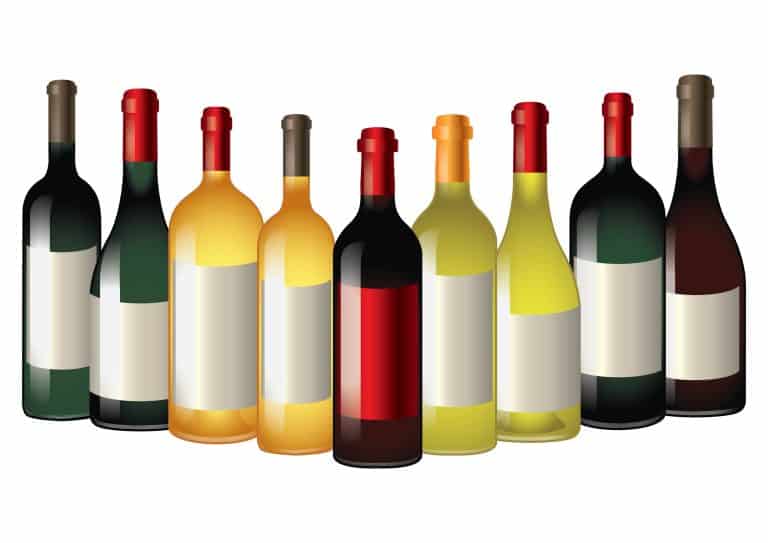Building a DIY wine cellar can be rewarding for any wine enthusiast. It provides a dedicated space for your collection, helps maintain ideal conditions for wine storage, and serves as a testament to your passion for the grape.
In this comprehensive guide, we’ll answer your question “how to build a wine cellar” through every process step, from initial planning and design to organization and long-term maintenance. We’ll explore the latest trends in wine cellar construction, learn the basic knowledge of wine preservation, and provide expert tips to help you make informed decisions.
By the end of this journey, you’ll be well-equipped to transform a simple storage space into a stunning sanctuary for your prized vintages.
So, uncork your favorite bottle, settle in, and get started.
Welcome to Didi Somm and Cheers!
Important Notice: The information in this article is for general and public information purposes only. It solely reflects Didi Somm’s or his Staff’s opinion, and no responsibility can be assumed for errors or omissions in the service’s contents. For details, please check the Disclaimer at the bottom of the homepage.

Main Takeaways
Proper planning is crucial: Assess your space, needs, and budget before starting.
Location matters: Choose a spot with stable temperature and humidity.
Climate control is non-negotiable: Invest in quality insulation and cooling systems.
Customize your design: Tailor your racking and layout to your collection and style.
Lighting is functional and aesthetic: LED lights create ambiance without heat.
Organization is key: Implement a system to track and manage your collection.
Personal touches make it unique: Add elements that reflect your passion for wine.
Regular maintenance ensures longevity: Keep your cellar clean and monitor conditions.
Professional help can be invaluable: Consider consulting experts for design and installation.
A wine cellar is an investment in your collection and your home’s value.
1. Assess Your Space and Needs
This initial assessment will form the foundation of your entire project, ensuring that your finished cellar meets your needs and expectations.
Consider the following factors:
- Available square footage: Measure your potential cellar space carefully. Even small areas can be transformed into efficient wine storage with clever design.
- Desired bottle capacity: Estimate how many bottles you want to store. Consider your current collection and future growth plans.
- Budget constraints: Determine how much you’re willing to invest in your cellar. Costs can vary widely depending on size, materials, and features.
- Existing structural elements: Assess any existing features, such as walls, doors, or windows, that might impact your design.
- Long-term plans: Consider how your wine-collecting habits might evolve. Will you focus on specific regions or varietals? Do you plan to age wines for extended periods?
Ask yourself these Important Questions:
By thoroughly answering the above questions, you’ll have a clearer vision of your ideal wine cellar and how it will function. This clarity will guide your decisions throughout the planning and construction process, helping you create a cellar that meets your needs.
2. Choose the Perfect Location
Selecting the right location for your wine cellar is paramount to its success. The ideal spot will provide a stable environment for your wines while fitting seamlessly into your home’s layout. Here are some crucial factors to consider when choosing your cellar’s location:
Temperature stability:
- Aim for a consistently cool environment, ideally between 55°F and 59°F (13°C to 15°C).
- Avoid areas prone to temperature fluctuations, such as rooms with exterior walls exposed to direct sunlight.
- Consider the impact of nearby heat sources like furnaces or hot water heaters.
Humidity control:
- Maintain relative humidity between 50-70% to prevent cork drying and label damage.
- Be wary of naturally damp areas that might promote mold growth.
- Consider using a hygrometer to monitor humidity levels accurately.
Minimal light exposure:
- Protect wines from harmful UV rays, which can degrade wine quality over time.
- Choose a location with no windows or plan to block any existing windows.
- If windows are unavoidable, consider using UV-blocking films or coverings.
Vibration-free zone:
- Avoid areas near appliances, elevators, or high-traffic zones that might cause vibrations.
- Constant vibrations can disturb wine sediment and potentially affect the aging process.
Accessibility:
- Consider how easily you can access the cellar to add new bottles and retrieve wines for consumption.
- If you plan to use the space for entertaining, ensure it’s conveniently located.
Potential for expansion:
If possible, choose a location that allows for future expansion of your collection.
Basements are often ideal locations for wine cellars due to their naturally cool and stable conditions. The below-ground environment typically maintains a more consistent temperature and humidity level, reducing the load on your climate control system.
However, with proper insulation and climate control, wine cellars can be created in various parts of your home. Some alternative locations to consider include:
Under-stair spaces
Converted closets or pantries
Spare bedrooms
Garage conversions
Dedicated outbuildings
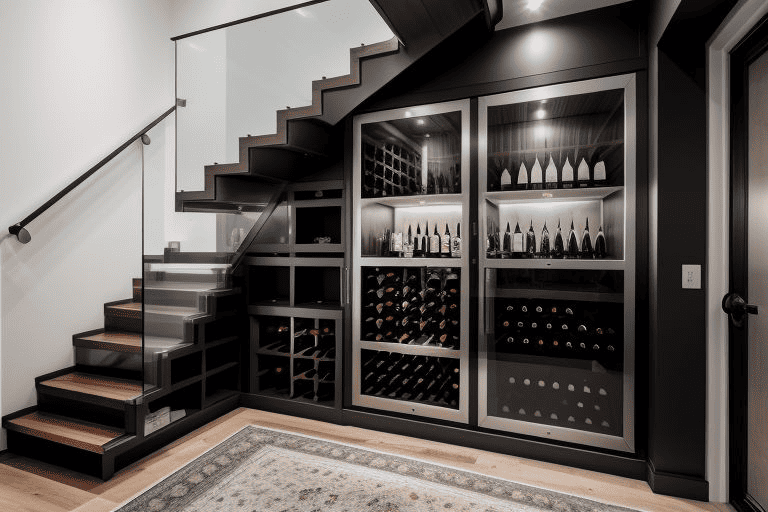
Additionally, a home wine cellar can be a great option. When considering one, pay attention to lighting options and framing construction. Thermally fused lights and UV-C technology (disinfecting) are often used, and proper framing can boost insulation and reduce energy consumption.
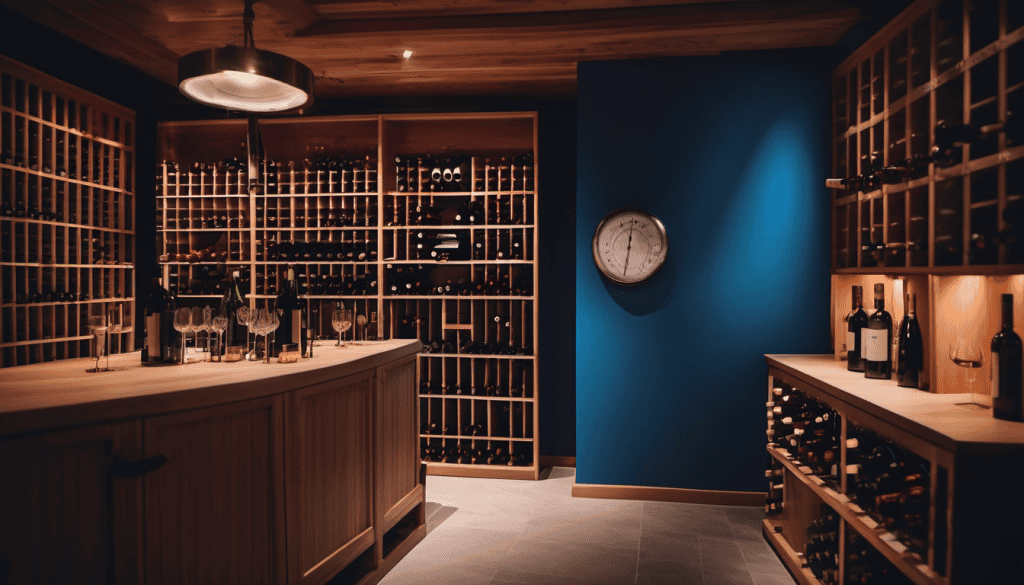
Important Remark: Regardless of your chosen location, proper insulation and a reliable climate control system can create an ideal wine storage environment in almost any part of your home.
3. Design Your Layout
Now comes the exciting part – designing your wine cellar’s layout! This is where you can let your creativity shine while ensuring your cellar is functional and aesthetically pleasing. A well-designed layout will maximize your storage capacity, showcase your collection effectively, and create an inviting space for wine appreciation.
Consider these key elements when designing your layout:
Wine Racking systems:
Choose from various styles to suit your collection and aesthetic preferences:
- Individual bottle racks: Ideal for showcasing labels and easy access to single bottles.
- Bulk storage: Efficient for large collections or case storage, perfect for investment wines.
- Diamond bins: Excellent for odd-shaped bottles or champagne.
- Display rows: Highlight special bottles or create visual interest in your cellar.
- High-reveal displays: Show off labels while storing bottles horizontally.

Materials:
Decide between different materials based on your style and budget – below are the most popular ones:
- Wood: Traditional and versatile, with options like redwood, mahogany, or oak.
- Metal: Modern and sleek, offering a contemporary look.
- Glass: Can be incorporated for a luxurious, showcase-style cellar.
- Stone: Depending on the type used, stone adds a rustic or high-end feel.
Author’s Tip: For more detailed information, please read the recently published article “From Wood to Stone – The Best 5 Wine Cabinet Materials for You“

Flooring:
Opt for moisture-resistant options that complement your overall design:
- Stone: Durable and naturally moisture-resistant.
- Tile: Wide variety of styles and easy to clean.
- Sealed concrete: Cost-effective and can be stained for added appeal.
- Cork: Naturally antimicrobial and provides insulation.
Lighting:
Incorporate LED lights for ambiance without heat emission:
- Recessed ceiling lights for overall illumination.
- Strip lighting under racking for a dramatic effect.
- Spot lighting to highlight special bottles or areas.
- Motion-activated options for energy efficiency.
Tasting area:
If space allows, include a small table and chairs for sampling and enjoying your collection:
- Consider a fold-down table to save space in smaller cellars.
- Install a wall-mounted glass rack for easy access to stemware.
- Add a decanting station with proper lighting for aeration.
Additional design considerations:
Traffic flow: Ensure aisles are wide enough for comfortable movement (typically 36-42 inches).
Cooling unit placement: Plan for proper ventilation and maintenance accessibility.
Door selection: Choose an exterior-grade door designed explicitly as a wine cellar door to ensure proper insulation and sealing and maintain ideal cellar conditions.
Wall treatments: Consider moisture-resistant paint or materials like stone veneer.
Important tip: Work with a professional designer or use 3D modeling software to visualize your space before committing to a final layout. It will help you identify potential issues and optimize your design before construction begins.
4. Invest in Proper Insulation
Maintaining a stable environment is crucial for wine preservation, and proper insulation is the key to achieving this. A well-insulated wine cellar protects your valuable collection and helps reduce energy costs associated with climate control. Here’s a summary of the best wine cellar insulation methods:
Types of Insulation:
Spray Foam Insulation:
Offers the highest R-value per inch (a measure of thermal resistance).
It creates an airtight seal and is excellent for vapor and moisture control, making it a top choice for wine cellar insulation.
It can be applied to irregular surfaces, ideal for existing structures.
Rigid Foam Boards:
High R-value and moisture resistance.
Easy to install in new constructions.
Available in different thicknesses to suit your needs.
Fiberglass Batts:
Cost-effective option for new constructions.
Must be paired with a proper vapor barrier.
Less effective in controlling moisture compared to foam options.
Key Insulation Areas:
Walls: Insulate all wine cellar walls, including those shared with interior spaces. Use 2×4 or 2×6 framing lumber for better insulation and energy efficiency. Consider pressure-treated lumber to prevent rot.
Ceiling: Crucial if there’s a heated room above the cellar.
Floor: Often overlooked but important for temperature stability.
Door: Use an exterior-grade, insulated door with weather stripping.
Windows: Double-paned or insulated glass if windows are present.
Vapor Barrier:
A vapor barrier is essential to prevent moisture from penetrating the walls and insulation:
- Install on the warm side of the insulation (outside the cellar).
- Use 6-mil polyethylene sheeting or a specialized vapor barrier product.
- Ensure all seams are properly sealed with vapor barrier tape.
Additional Insulation Tips:
- Aim for an R-value of at least R-19 for walls and R-30 for ceilings.
- Seal all gaps and cracks to create an airtight space.
- Pay special attention to areas around electrical outlets and light fixtures.
- Consider using insulated racks to minimize thermal bridging.
Professional Installation:
– Identification and addressing of potential problem areas.
Important Tip: Proper insulation protects your wine and helps reduce energy costs associated with climate control. It’s an upfront investment that pays dividends in the long-term preservation of your collection and the efficiency of your cellar.
5. Install a Wine Cellar Cooling System
A reliable climate control system is the heart of any wine cellar, ensuring that your precious bottles are stored in optimal conditions year-round. Here’s an in-depth look at what you need to know about selecting and installing the right system for your cellar:
Types of Wine Cellar Cooling Systems:
Split Systems:
- Consists of separate evaporator and condensing units.
- Quieter operation as the condensing unit is located outside the cellar.
- Better for larger cellars or where noise reduction is a priority.
2. Ducted Systems:
- The cooling unit is located away from the cellar, with cool air ducted in.
- Provides silent operation within the cellar.
- Ideal for large cellars or where aesthetic considerations are paramount.
Through-the-Wall Systems:
- Similar to self-contained units but designed to fit between wall studs.
- Suitable for small cellars where space is at a premium.
Key Factors to Consider:
- Cellar Size: Choose a wine cooling system sized appropriately for your space. Undersized units will struggle to maintain proper conditions.
- Temperature Range: Ensure the system can maintain a consistent temperature between 55°F and 59°F.
- Humidity Control: Look for units with both cooling and humidity control capabilities. The ideal relative humidity is between 50% and 70%.
- Noise Level: Consider the decibel rating, especially if the cellar is near living areas.
- Energy Efficiency: Look for Energy Star-rated units to minimize operating costs.
- Installation Requirements: Ensure proper electrical supply and ventilation for the chosen system.

Additional Features to Consider:
- Remote monitoring capabilities for temperature and humidity.
- Alarm systems to alert you of any significant fluctuations.
- Automatic defrost to prevent ice buildup on the evaporator coil.
- Multiple fan speeds for better temperature control and energy efficiency.
Installation Tips:
- Proper placement is crucial for efficient operation. Follow manufacturer guidelines for clearances and airflow.
- Ensure the cellar is well-sealed before installing the cooling system.
- Consider professional installation to ensure optimal performance and warranty coverage.
- Install a backup power source or generator to protect your collection during outages.
Maintenance:
- Regular maintenance is key to system longevity and efficiency.
- Clean or replace air filters as recommended by the manufacturer.
- Schedule annual professional servicing to check refrigerant levels and overall system performance.
Consulting with Professionals:
It’s highly recommended that you consult with HVAC professionals specializing in wine cellar systems. They can:
- Perform a heat load calculation to determine the exact cooling capacity needed.
- Recommend the most suitable system for your specific cellar design and location.
- Ensure proper installation and setup for optimal performance.
Important Tip: A high-quality, adequately sized climate control system will provide the best possible environment for your wines to age gracefully.
6. Select the Right Racking System
Your racking system will determine how you store and display your wines. The right choice will maximize your storage capacity while showcasing your collection beautifully.
Here’s an in-depth look at various racking options and considerations:
Types of Wine Racks:
Individual Bottle Racks:
Ideal for showcasing labels and easy access to single bottles.
Available in multiple configurations (single deep, double deep, etc.).
Perfect for collectors who frequently rotate their stock.
Bulk Storage Bins:
Efficient for large collections or case storage.
Ideal for investment wines or those aging for extended periods.
Can accommodate odd-shaped bottles more easily.
Diamond Bins:
Excellent for odd-shaped bottles or champagne.
Adds visual interest to your cellar design.
Can be combined with other rack types for a custom look.
Display Rows:
Highlight special bottles or create visual interest.
Often angled for better label visibility.
Great for showcasing prized vintages or rare finds.
High-Reveal Display Racks:
Show off labels while storing bottles horizontally.
Combines proper storage position with visual appeal.
Often used for higher-end bottles or tasting areas.
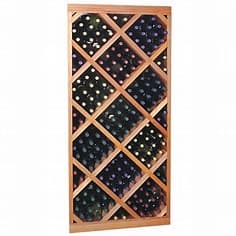
Materials to Consider:
1. Wood:
- Traditional and versatile.
- Options include redwood, mahogany, oak, and pine.
- Can be stained or left natural to match your cellar’s aesthetic.
2. Metal:
- Modern and sleek.
- Durable and easy to clean.
- Can provide a contemporary or industrial look.
- Creates a floating or invisible effect.
3. Acrylic or Plexiglass:
- Great for modern, minimalist designs.
- Allows for unobstructed views of your collection.
4. Stone:
- Adds a luxurious, high-end feel.
- Can be integrated with stone wall features.
- Typically custom-designed for the space.
Customization Options:
- Modular systems for flexibility and future expansion.
- Custom-sized racks for unique bottle shapes or sizes.
- Integrated LED lighting for dramatic effect.
- Combination of different rack types for varied storage needs.
Considerations When Choosing Racking:
1. Bottle Capacity: Ensure your chosen system meets your current and future storage needs.
2. Bottle Sizes: Account for various bottle shapes and sizes in your collection.
3. Accessibility: Consider how easily you can retrieve and replace bottles.
4. Cellar Layout: Choose racks that maximize your available space and complement your cellar design.
5. Airflow: Ensure proper air circulation around bottles for consistent temperature.
6. Weight Capacity: Verify that your chosen racks can support the weight of your collection, especially for bulk storage.
7. Aesthetics: Select a style that aligns with your overall cellar design and personal taste.
8. Budget: Balance quality and capacity with your available budget.
My Tip: For information on wine racking systems, designs, materials, etc., I recommend checking the following website, Wine Racks America – a top address in the business.
Installation Tips:
- Ensure racks are level and securely anchored to walls or floors.
- Leave adequate space between racks for easy access and air circulation.
- Consider professional installation for complex or custom systems
By carefully selecting and combining different racking styles, you can create a unique and functional storage system tailored to your collection. Remember, your racking is not just for storage – it’s a key design element that will define the look and feel of your wine cellar.
7. Implement Proper Lighting
Lighting plays a crucial role in your wine cellar’s functionality and ambiance. When done right, it can transform your cellar from a simple storage space into a stunning showcase for your collection. Here’s a comprehensive guide to implementing the perfect lighting system:
Types of Lighting to Consider:
1. Ambient Lighting:
- Provides overall illumination for the space.
- Options include recessed ceiling lights, chandeliers, or pendant lights.
- Choose dimmable fixtures for adjustable light levels.
2. Accent Lighting:
- Highlights specific areas or bottles.
- Use LED strip lights under shelves or along rack edges.
- Consider spotlights to showcase prized vintages or artwork.
3. Task Lighting:
- Illuminates work areas like tasting tables or decanting stations.
- Under-cabinet lights or adjustable sconces work well.
- Ensure adequate brightness for reading labels and performing tasks.
4. Decorative Lighting:
- Adds visual interest and enhances the cellar’s aesthetic.
- Options include wine bottle lights, backlit onyx panels, or fiber optic star ceilings.
- Use creatively to reflect your style.
Key Lighting Considerations:
1. Heat Emission:
- Use LED lights to minimize heat, which can affect wine temperature.
- Avoid incandescent bulbs, which generate significant heat.
2. UV Protection:
- Choose bulbs that emit minimal or no UV rays to protect wine from light damage.
- Consider UV-filtered bulbs if using non-LED options.
3. Color Temperature:
- Opt for warm white lights (2700K-3000K) for a cozy, inviting atmosphere.
- Cool white lights can create a modern, crisp look but may feel clinical in a cellar setting.
4. Dimmer Switches:
- Install dimmer switches for adjustable lighting levels.
- Creates flexibility for different moods and occasions.
5. Energy Efficiency:
- LED lights are highly energy-efficient and long-lasting.
- Consider smart lighting systems for automated control and energy savings.
6. Placement:
- Strategically position lights to avoid direct exposure on wine bottles.
- Use indirect lighting to create a soft, diffused glow.
7. Moisture Resistance:
- Choose fixtures rated for damp locations to withstand cellar humidity.
- Ensure all electrical components are properly sealed and protected.
Advanced Lighting Features:
1. Motion Sensors:
- Install motion-activated lights to conserve energy.
- Adds a touch of luxury and convenience to your cellar.
2. Color-Changing LEDs:
- Create different moods with adjustable color options.
- Can be programmed for special events or seasonal themes.
3. Programmable Lighting Scenes:
- Set up pre-programmed lighting configurations for various occasions.
- Integrate with smart home systems for easy control.
4. Backlit Labels:
- Use small LED lights behind bottle labels for a dramatic display.
- Great for showcasing special vintages or creating a feature wall.
Installation Tips:
- Plan your lighting layout early in the design process.
- Consult with a licensed electrician to ensure proper wiring and safety.
- Consider future needs and install extra electrical outlets for flexibility.
- Use a mix of lighting types for the most dynamic and functional space.
Maintenance:
- Regularly dust light fixtures to maintain brightness and efficiency.
- Replace bulbs promptly to ensure consistent lighting.
- Periodically check and tighten any loose connections.
Important Tip: Carefully consider your lighting options and implement a well-designed system to create an appealingImportantly Important Tip: A robust organization system will not only enhance the functionality of your wine cellar but also deepen your appreciation and understanding of your collection. An organized cellar makes it easier to enjoy your wines at their best and share them with fellow enthusiasts.
9. Add Personal Touches
Your wine cellar is more than just a storage space—it reflects your passion for wine and your style. Adding unique touches will transform your cellar from a functional storage area into a stunning showcase that tells your wine story.
Here’s how to infuse your personality into your cellar design:
Thematic Elements:
1. Regional Focus:
- Incorporate decor from your favorite wine regions.
- Display maps of wine countries or specific appellations.
- Use regional artwork or photographs to create a sense of place.
2. Historical Tribute:
- Showcase antique corkscrews, decanters, or wine-making tools.
- Display vintage wine advertisements or labels.
- Incorporate reclaimed wood or barrel staves into your design.

3. Modern Aesthetic:
- Use sleek, minimalist racking systems.
- Incorporate glass and metal elements for a contemporary feel.
- Install modern lighting fixtures or LED strip lighting.
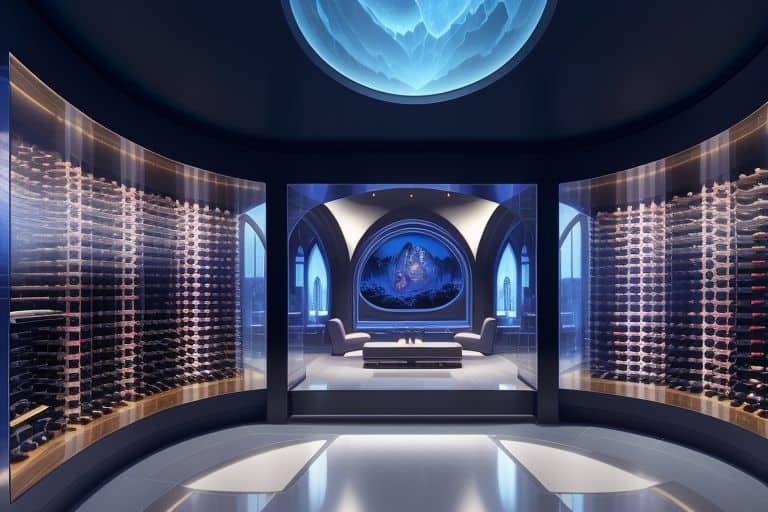
Decorative Features:
1. Wine-Related Art:
- Hang paintings or photographs with wine themes.
- Commission custom artwork featuring your favorite wines or vineyards.
- Display wine-inspired sculptures or installations.
2. Unique Fixtures:
- Install a custom-designed chandelier made from wine bottles or corks.
- Use wine barrel rings as decorative elements or light fixtures.
- Incorporate wine-themed door handles or cabinet knobs.
3. Textural Elements:
- Add a stone or brick accent wall for a rustic feel.
- Use cork flooring or wall coverings for sound absorption and visual interest.
- Incorporate wine crate panels or barrel staves into wall designs.
Functional Additions:
1. Tasting Area:
- Install a custom-built tasting table and comfortable seating.
- Include proper stemware storage and display.
- Add a small sink or spittoon for serious tasting sessions.
2. Decanting Station:
- Set up a dedicated area for decanting with proper lighting.
- Display your collection of decanters as functional art.
3. Temperature and Humidity Display:
- Install an attractive digital or analog thermometer/hygrometer.
- Consider a weather station-style display for a technical touch.
4. Label Preservation:
- Create a “wall of fame” to display labels from memorable bottles.
- Use a label removal tool and album to preserve special memories.
Personal Collections:
1. Showcase Vertical Collections:
- Design special racking or display areas for vertical collections of your favorite wines.
2. Highlight Rare or Prized Bottles:
- Use individual bottle lighting or display cases for your most treasured wines.
3. Wine Journey Map:
- Create a custom map marking the vineyards you’ve visited or hope to visit.
4. Tasting Journal Display:
- Keep your tasting notes on display, perhaps in a beautiful leather-bound book.
Interactive Elements:
1. Chalkboard or Whiteboard Wall:
- Use it for writing tasting notes, marking special occasions, or leaving messages for guests.
2. Digital Wine List:
- Install a tablet or small screen with your digital inventory for easy browsing.
3. Educational Corner:
- Set up a small library of wine books or a digital display with wine education content.
Sensory Enhancements:
1. Sound System:
- Install speakers for background music during tastings or gatherings.
2. Scent:
- Use subtle, wine-complementary scents like cedar or vanilla to enhance the ambiance.
3. Texture:
- Incorporate various textures in your design, from smooth glass to rough stone, for a multi-sensory experience.
Personalized Branding:
1. Custom Signage:
- Create a customized sign or logo for your cellar entrance.
2. Family Crest or Monogram:
- Incorporate your family crest (picture below) or monogram into the cellar design.

3. Signature Color Scheme:
- Make your favorite colors in the cellar’s design elements uniquely yours.
Important Tip: Adding your personal touches will create a space that resonates with your wine journey and personal taste. Whether you prefer a classic Old World feel or a modern, sleek design, your wine cellar should be a space you love spending time in and sharing with others.
10. Maintain Your Wine Cellar
Regular maintenance is key to preserving your investment and ensuring optimal conditions for your wines. A well-maintained cellar protects your collection, extends the life of your equipment, and preserves your space’s aesthetic appeal.
Here’s how to keep your wine cellar in top condition:
Climate Control Maintenance:
1. Monitor Temperature and Humidity:
- Check levels daily or install a remote monitoring system.
- Ideal temperature: 55°F to 59°F (13°C to 15°C)
- Ideal humidity: 50-70% relative humidity
2. Calibrate Sensors:
- Regularly calibrate temperature and humidity sensors for accuracy.
- Consider using multiple sensors in different areas of the cellar.
3. Service Cooling System:
- Schedule annual professional maintenance for your cooling unit.
- Clean or replace air filters monthly or as recommended by the manufacturer.
- Check for unusual noises or reduced efficiency, which may indicate issues.
Cleanliness and Hygiene:
1. Dust and Clean Regularly:
- Dust racks, bottles, and surfaces weekly to prevent buildup.
- Use a soft, lint-free cloth to avoid scratching bottles or racks.
2. Floor Maintenance:
- Sweep or vacuum floors weekly.
- Mop with a gentle, non-toxic cleaner monthly, avoiding excess moisture.
3. Prevent Mold and Mildew:
- Inspect for signs of mold or mildew, especially in corners and on corks.
- Address any moisture issues promptly to prevent growth.
4. Clean Light Fixtures:
- Dust light fixtures monthly to maintain optimal illumination.
- Replace bulbs as needed, using appropriate wine cellar-friendly options.
Bottle Care:
1. Rotate Bottles:
- Gently rotate stored bottles quarterly to keep corks moist.
- Be careful not to disturb sediment in older wines.
2. Inspect Labels:
- Check for any damage or peeling labels.
- Consider using label protectors for valuable or rare bottles.
3. Check for Leaks:
- Regularly inspect bottles for signs of seepage or cork failure.
- Remove any compromised bottles immediately to prevent contamination.
Inventory Management:
1. Update Records:
- Keep your inventory system current, adding new purchases and removing consumed bottles.
- Regularly review drinking windows and adjust storage locations as needed.
2. Conduct Annual Audits:
- Perform a thorough inventory check at least once a year.
- Use this opportunity to reorganize and optimize your storage layout.
Structural Maintenance:
1. Check Seals:
- Inspect door seals and weather stripping annually, replacing them as needed.
- Ensure windows (if any) are properly sealed.
2. Examine Insulation:
- Look for any signs of degradation in visible insulation.
- Address any cold spots or areas of condensation promptly.
3. Maintain Racks:
- Tighten any loose screws or fittings in your racking system.
- Check for any signs of warping or damage, especially in wooden racks.
Pest Prevention:
1. Regular Inspections:
- Check for signs of pests, including insects or rodents.
- Pay special attention to dark corners and under racks.
2. Seal Entry Points:
- Ensure all potential entry points are sealed, including small gaps around pipes or vents.
3. Use Wine-Safe Pest Control:
- If necessary, use safe pest control methods for wine storage areas.
Emergency Preparedness:
1. Backup Power:
- Test your backup power system regularly if you have one.
- Consider installing an alarm system to alert you of power failures or temperature fluctuations.
2. Emergency Plan:
- Develop a plan for moving your collection in case of extended power outages or natural disasters.
- Keep an updated inventory with values for insurance purposes.
Professional Assessments:
1. Annual Inspections:
- Consider having a wine cellar specialist conduct an annual inspection.
- They can identify potential issues before they become problems and suggest optimizations.
2. Equipment Servicing:
- All mechanical equipment, including cooling systems and humidifiers, must be professionally serviced annually.
Important Tip: Following these maintenance guidelines will ensure that your wine cellar remains pristine and that your collection thrives for years.
FAQ – “How to build a wine cellar”
Q: How much does it cost to build a wine cellar?
A: The cost of building a wine cellar can vary greatly depending on size, materials, and features. A small, basic cellar might start around $5,000, while high-end custom cellars can exceed $100,000. Factors like cooling systems, racking, and finishes significantly impact the final price.
Q: Can I build a wine cellar in a small space?
A: Absolutely! With careful planning and space-saving solutions like high-density racking or under-stair storage, you can create a functional wine cellar even in compact areas. Some enthusiasts have converted closets or small rooms into efficient wine storage spaces.
Q: Do I need a professional to design my wine cellar?
A: While it’s possible to design a wine cellar yourself, working with a professional can ensure optimal layout, proper climate control, and adherence to building codes. Their expertise can be invaluable, especially for larger or more complex projects.
Q: How long does it take to build a wine cellar?
A: The timeline for building a wine cellar can range from a few weeks for simple conversions to several months for custom, high-end projects. Factors like permits, custom features, and contractor availability can affect the timeline.
Q: Can I store other beverages in my wine cellar?
A: While wine cellars are designed primarily for wine storage, you can undoubtedly store other beverages like craft beers or spirits. Just be mindful of their specific storage requirements, which may differ from wine ones.
Q: What’s the ideal temperature for a wine cellar?
A: The ideal temperature for long-term wine storage is between 55°F and 59°F (13°C to 15°C). This range slows the aging process, allowing wines to develop complexity over time.
Q: How important is humidity in a wine cellar?
A: Humidity is crucial in a wine cellar. The ideal relative humidity range is 50-70%. This level helps keep corks moist, preventing them from drying out and allowing air to seep into the bottles.
Q: Can I build a wine cellar in an upstairs room?
A: You can build a wine cellar upstairs, but it requires careful planning and construction. Upstairs cellars often need more insulation and a powerful cooling system to maintain proper conditions.
Q: What type of lighting is best for a wine cellar?
A: LED lighting is ideal for wine cellars. It produces minimal heat, is energy-efficient, and can be dimmed to create the right ambiance. Avoid incandescent bulbs, which emit heat, and fluorescent lights, which can produce UV rays harmful to wine.
Q: How many bottles can I store in my wine cellar?
A: The number of bottles you can store depends on your cellar’s size and racking configuration. Generally, you can estimate about 100 bottles per 25 square feet of space.
Q: Do I need a vapor barrier in my wine cellar?
A: Yes, a vapor barrier is essential in a wine cellar. It prevents moisture from penetrating the walls and insulation, which can lead to mold growth and structural damage.
Q: What’s the best flooring for a wine cellar?
A: The best flooring options for wine cellars are moisture-resistant and durable materials like stone, tile, or sealed concrete. These materials can withstand high humidity levels and are easy to clean.
Q: How often should I service my wine cellar cooling system?
A: It’s recommended that your wine cellar cooling system be professionally serviced at least once a year. Regular maintenance ensures optimal performance, energy efficiency, and system longevity.
Q: Can I use a regular air conditioner for my wine cellar?
A: Standard air conditioners are not recommended for wine cellars. They don’t provide the consistent temperature and humidity control needed for proper wine storage. Specialized wine cellar cooling systems are designed to maintain the specific conditions required for wine preservation.
Q: How do I protect my wine collection from power outages?
A: To protect your wine during power outages, consider installing a backup power system or generator specifically for your wine cellar. Additionally, a well-insulated cellar can maintain stable temperatures for several hours during an outage.
Q: How do I build my own wine cellar, and why is it important?
A: Building your own wine cellar involves careful planning, selecting suitable materials, and ensuring proper climate control. This is important because a well-constructed wine cellar provides the ideal environment for aging wine, preserving its quality and value over time. Proper storage conditions, including temperature and humidity control, are crucial for maintaining the integrity of your wine collection.
Conclusion:
Creating your dream wine cellar is an exciting journey that combines passion, creativity, and technical expertise. By following this ultimate guide, you’ll be well-equipped to design and build a space that preserves your wine collection and serves as a personal sanctuary where you can nurture your passion, entertain friends, and create lasting memories.
As you embark on this journey, remember that flexibility and adaptability are key. Your wine collection and preferences may evolve, so design your cellar with room for growth and changes. Regular maintenance and care will ensure that your investment continues to provide optimal conditions for your wines and remains a source of pride and enjoyment for years.
So, raise a glass to your new project, and get ready to uncork the potential of your perfect wine cellar. Here’s to the wonderful world of wine and the joy of having a dedicated space to celebrate it – Cheers!
For your reference, the latest articles by Didi Somm include:
- Best Red Wine For Cooking – All You Need To Know
- How Much Does a Bottle of Wine Weigh? – Find Out Here
- What Does Wine Taste Like? – Find Out Here
- Expert Talk: Wine Bottle Sizes – All You Should Know
- What is a Sweet Wine? – 7 Expert Insights
- How to Use Dry White Wine for Cooking? – Your Best Guide
Important Notice: The information in this article is for general and public information purposes only. It solely reflects Didi Somm’s or his Staff’s opinion, and no responsibility can be assumed for errors or omissions in the service’s contents. For details, please check the Disclaimer at the bottom of the homepage.


